Dynamically Coupled Reservoir and Wellbore Simulation Research in Two-Phase Flow Systems: A Critical Review
Abstract
:1. Introduction
2. The Drift-Flux Model
2.1. Role of Drift-Flux Models
2.2. Description of a Basic DF Model
2.3. Unified Gas/Liquid DF Models for Coupled Reservoir/Wellbore Simulators
3. Coupled Reservoir/Wellbore Modeling
3.1. Reservoir Modeling
3.2. Wellbore Modeling
3.3. Numerical Implementation of Coupling Reservoir and Wellbore Models
4. Applications of Coupled Reservoir/Wellbore Simulators
4.1. Typical Application 1—Gas Coning
4.2. Typical Application 2—Well Storage Effect
4.3. Typical Application 3—Liquid Loading
4.4. Typical Application 4—General Scenarios
5. Summary
Author Contributions
Funding
Institutional Review Board Statement
Informed Consent Statement
Data Availability Statement
Conflicts of Interest
References
- Alberts, G.; Belfroid, S.; Peters, L.; Joosten, G.J. An Investigation into the Need of a Dynamic COUPLED well-Reservoir Simulator. In Proceedings of the SPE Annual Technical Conference and Exhibition, Anaheim, CA, USA, 11–14 November 2007. [Google Scholar] [CrossRef]
- da Silva, D.; Jansen, J. A Review of Coupled Dynamic Well-Reservoir Simulation. IFAC-PapersOnLine 2015, 48, 236–241. [Google Scholar] [CrossRef]
- Belfroid, S.; Sturm, W.; Alberts, G.; Peters, R.; Schiferli, W. Prediction of well performance instability in thin layered reservoirs. In Proceedings of the SPE Annual Technical Conference and Exhibition, Dallas, TX, USA, 9–12 October 2005. [Google Scholar] [CrossRef]
- Nennie, E.D.; Alberts, G.J.N.; Peters, L.; van Donkelaar, E. Using a Dynamic Coupled Well-Reservoir Simulator to Optimize Production of a Horizontal Well in a Thin Oil Rim. In Proceedings of the Abu Dhabi International Petroleum Exhibition and Conference, Abu Dhabi, UAE, 3–6 November 2008. [Google Scholar] [CrossRef]
- Hasan, A.R.; Kabir, C.S.; Wang, X. Development and Application of a Wellbore/Reservoir Simulator for Testing Oil Wells. SPE Form. Evaluation 1997, 12, 182–188. [Google Scholar] [CrossRef]
- Hasan, A.R.; Kabir, C.S.; Wang, X. Wellbore Two-Phase Flow and Heat Transfer During Transient Testing. SPE J. 1998, 3, 174–180. [Google Scholar] [CrossRef]
- Izgec, B.; Kabir, C.S.; Zhu, D.; Hasan, A.R. Transient Fluid and Heat Flow Modeling in Coupled Wellbore/Reservoir Systems. In Proceedings of the SPE Annual Technical Conference and Exhibition, San Antonio, TX, USA, 24–27 September 2006. [Google Scholar] [CrossRef]
- Kabir, C.S.; Hasan, A.R.; Jordan, D.L.; Wang, X. A Wellbore/Reservoir Simulator for Testing Gas Wells in High-Temperature Reservoirs. SPE Form. Evaluation 1996, 11, 128–134. [Google Scholar] [CrossRef]
- Coats, B.; Fleming, G.; Watts, J.; Rame, M.; Shiralkar, G. A Generalized Wellbore and Surface Facility Model, Fully Coupled to a Reservoir Simulator. In Proceedings of the SPE Annual Technical Conference and Exhibition, Houston, TX, USA, 3–5 February 2003. [Google Scholar] [CrossRef]
- Kosmala, A.; Aanonsen, S.I.; Gajraj, A.; Biran, V.; Brusdal, K.; Stokkenes, A.; Torrens, R. Coupling of a Surface Network With Reservoir Simulation. In Proceedings of the SPE Reservoir Simulation Symposium, Denver, CO, USA, 5–8 October 2003. [Google Scholar] [CrossRef]
- Zapata, V.J.; Brummett, W.M.; Osborne, M.E.; Van Nispen, D.J. Advances in Tightly Coupled Reservoir/ Wellbore/Surface-Network Simulation. SPE Reserv. Evaluation Eng. 2001, 4, 114–120. [Google Scholar] [CrossRef]
- Holmes, J.; Barkve, T.; Lund, O. Application of a Multisegment Well Model to Simulate Flow in Advanced Wells. In Proceedings of the European petroleum conference, The Hague, Netherlands, 20–22 October 1998. [Google Scholar] [CrossRef]
- Miller, C.W. Wellbore Storage Effects in Geothermal Wells. Soc. Pet. Eng. J. 1980, 20, 555–566. [Google Scholar] [CrossRef]
- Almehaideb, R.A.; Aziz, K.; Pedrosa, O.J. A Reservoir/Wellbore Model for Multiphase Injection and Pressure Transient Analysis. In Proceedings of the Middle East Oil Show, Bahrain Exhibition Center, Sanabis, Bahrain, 11–14 March 1989. [Google Scholar] [CrossRef]
- Bahonar, M.; Azaiez, J.; Chen, Z.J. Transient Nonisothermal Fully Coupled Wellbore/Reservoir Model for Gas-Well Testing, Part 1: Modelling. J. Can. Pet. Technol. 2011, 50, 37–50. [Google Scholar] [CrossRef]
- Bhat, A.; Swenson, D.; Gosavi, S. Coupling the HOLA wellbore simulator with TOUGH2. In Proceedings of the 30th Workshop on Geothermal Reservoir Engineering, Stanford, CA, USA, 31 January–2 February 2005. [Google Scholar]
- Cao, H.; Samier, P.; Kalunga, H.; Detige, E.; I Obi, E. A Fully Coupled Network Model, Practical Issues and Comprehensive Comparison with Other Integrated Models on Field Cases. In Proceedings of the SPE Annual Technical Conference and Exhibition, Houston, TX, USA, 28–30 September 2015. [Google Scholar] [CrossRef]
- Holmes, J. Enhancements to the Strongly Coupled, Fully Implicit Well Model: Wellbore Crossflow Modeling and Collective Well Control. In Proceedings of the SPE Reservoir Simulation Symposium, San Francisco, CA, USA, 15–18 November 1983. [Google Scholar] [CrossRef]
- Leemhuis, A.P.; Nennie, E.D.; Belfroid, S.P.C.; Alberts, G.J.N.; Peters, L.; Joosten, G.J. Gas Coning Control for Smart Wells Using a Dynamic Coupled Well-Reservoir Simulator. In Proceedings of the Intelligent Energy Conference and Exhibition, Amsterdam, The Netherlands, 25–27 February 2008. [Google Scholar] [CrossRef]
- Livescu, S.; Durlofsky, L.; Aziz, K.; Ginestra, J. A fully-coupled thermal multiphase wellbore flow model for use in reservoir simulation. J. Pet. Sci. Eng. 2010, 71, 138–146. [Google Scholar] [CrossRef]
- Pan, L.; Oldenburg, C.M. T2Well—an integrated wellbore–reservoir simulator. Comput. Geosci. 2014, 65, 46–55. [Google Scholar] [CrossRef]
- Pourafshary, P. A Coupled Wellbore/Reservoir Simulator to Model Multiphase Flow and Temperature Distribution. Ph.D. Thesis, The University of Texas, Austin, TX, USA, 2007. [Google Scholar]
- Sagen, J.; Østenstad, M.; Hu, B.; Henanger, K.E.I.; Lien, S.K.; Xu, Z.-G.; Groland, S.; Sira, T. A Dynamic Model for Simulation of Integrated Reservoir, Well and Pipeline System. In Proceedings of the SPE Annual Technical Conference and Exhibition, Denver, CO, USA, 30 October–2 November 2011. [Google Scholar] [CrossRef]
- Satti, R.P.; Gilliat, J.; Bale, D.S.; Hillis, P.; Myers, B.; Harper, J. Application of a Transient Near-Wellbore / Reservoir Simulator for Complex Completions Design. In Proceedings of the Offshore Technology Conference Brasil, Rio de Janeiro, Brazil, 29–31 October 2019. [Google Scholar] [CrossRef]
- Stone, T.W.; Bennett, J.; Law, D.H.S.; Holmes, J.A. Thermal Simulation with Multisegment Wells. SPE Reserv. Evaluation Eng. 2002, 5, 206–218. [Google Scholar] [CrossRef]
- Stone, T.; Edmunds, N.; Kristoff, B. A Comprehensive Wellbore/Reservoir Simulator. In Proceedings of the SPE Symposium on Reservoir Simulation, Houston, TX, USA, 6–8 February 1989. [Google Scholar] [CrossRef]
- Sturm, W.; Belfroid, S.; Van Wolfswinkel, O.; Peters, M.; Verhelst, F. Dynamic reservoir well interaction. In Proceedings of the SPE Annual Technical Conference and Exhibition, Houston, TX, USA, 26–29 September 2004. [Google Scholar] [CrossRef]
- Tang, H.; Hasan, A.R.; Killough, J. Development and Application of a Fully Implicitly Coupled Wellbore/Reservoir Simulator to Characterize the Transient Liquid Loading in Horizontal Gas Wells. SPE J. 2018, 23, 1615–1629. [Google Scholar] [CrossRef]
- Twerda, A.; Nennie, E.D.; Alberts, G.; Leemhuis, A.P.; Widdershoven, C. To ICD or Not to ICD? A Techno-economic Analysis of Different Control Strategies Applied to a Thin Oil Rim Dield Case. In Proceedings of the SPE Middle East Oil and Gas Show and Conference, Manama, Bahrain, 25–28 September 2011. [Google Scholar] [CrossRef]
- Winterfeld, P.H. Simulation of Pressure Buildup in a Multiphase Wellbore/Reservoir System. SPE Form. Evaluation 1989, 4, 247–252. [Google Scholar] [CrossRef]
- Battistelli, A.; Finsterle, S.; Marcolini, M.; Pan, L. Modeling of coupled wellbore-reservoir flow in steam-like supercritical geothermal systems. Geothermics 2020, 86, 101793. [Google Scholar] [CrossRef]
- Basirat, F.; Yang, Z.; Bensabat, J.; Levchenko, S.; Pan, L.; Niemi, A. Characterization of CO2 self-release during Heletz Residual Trapping Experiment I (RTE I) using a coupled wellbore-reservoir simulator. Int. J. Greenh. Gas Control 2020, 102, 103162. [Google Scholar] [CrossRef]
- Galvao, M.S.; Carvalho, M.S.; Barreto, A.B. A coupled transient wellbore/reservoir-temperature analytical mode. SPE J. 2020, 24, 2335–2361. [Google Scholar] [CrossRef]
- Raad, S.M.J.; Lawton, D.; Maidment, G.; Hassanzadeh, H. Transient non-isothermal coupled wellbore-reservoir modeling of CO2 injection—Application to CO2 injection tests at the CaMI FRS site, Alberta, Canada. Int. J. Greenh. Gas Control. 2021, 111, 103462. [Google Scholar] [CrossRef]
- Liao, Y.; Wang, Z.; Chao, M.; Sun, X.; Wang, J.; Zhou, B.; Sun, B. Coupled wellbore–reservoir heat and mass transfer model for horizontal drilling through hydrate reservoir and application in wellbore stability analysis. J. Nat. Gas Sci. Eng. 2021, 95, 104216. [Google Scholar] [CrossRef]
- Hasan, A.R.; Kabir, C.S.; Sarica, C. Fluid Flow and Heat Transfer in Wellbores; Society of Petroleum Engineers: Richardson, TX, USA, 2002. [Google Scholar]
- Shoham, O. Mechanistic Modeling of Gas-Liquid Two-Phase Flow in Pipes; SPE: Richardson, TX, USA, 2006. [Google Scholar] [CrossRef]
- Aziz, K. Petroleum Reservoir Simulation; Applied Science Publishers: London, UK, 1979; p. 476. [Google Scholar]
- Chen, Z. Reservoir Simulation: Mathematical Techniques in Oil Recovery; Society for Industrial and Applied Mathematics: Philadelphia, PA, USA, 2007. [Google Scholar]
- Iemcholvilert, S. A Research on Production Optimization of Coupled Surface and Subsurface Model. Master’s Thesis, Texas A&M University, College Station, TX, USA, 2013. [Google Scholar]
- Chen, Z.; Huan, G.; Ma, Y. Computational Methods for Multiphase Flows in Porous Media; Society for Industrial and Applied Mathematics: Philadelphia, PA, USA, 2006. [Google Scholar] [CrossRef]
- Beggs, D.H.; Brill, J.P. A Study of Two-Phase Flow in Inclined Pipes. J. Pet. Technol. 1973, 25, 607–617. [Google Scholar] [CrossRef]
- Hagedorn, A.R.; Brown, K.E. Experimental Study of Pressure Gradients Occurring During Continuous Two-Phase Flow in Small-Diameter Vertical Conduits. J. Pet. Technol. 1965, 17, 475–484. [Google Scholar] [CrossRef]
- Moissis, R.; Griffith, P. Entrance effects in a two-phase slug flow. J. Heat Transfer 1962, 84, 366–370. [Google Scholar] [CrossRef]
- Orkiszewski, J. Predicting Two-Phase Pressure Drops in Vertical Pipe. J. Pet. Technol. 1967, 19, 829–838. [Google Scholar] [CrossRef]
- Ros, N. Simultaneous Flow of Gas and Liquid as Encountered in Well Tubing. J. Pet. Technol. 1961, 13, 1037–1049. [Google Scholar] [CrossRef]
- Holmes, J. Description of the Drift Flux Model in the LOCA Codes RELAPUK. In Proceedings of the Heat and Fluid Flow in Water Reactor Safety, Manchester, UK, 13–15 September 1977. [Google Scholar]
- Forouzanfar, F.; Pires, A.; Reynolds, A.C. Formulation of a Transient Multi-Phase Thermal Compositional Wellbore Model and its Coupling with a Thermal Compositional Reservoir Simulator. In Proceedings of the SPE Annual Technical Conference and Exhibition, Houston, TX, USA, 28–30 September 2015. [Google Scholar] [CrossRef]
- Livescu, S.; Durlofsky, L.J.; Aziz, K. A Semianalytical Thermal Multiphase Wellbore-Flow Model for Use in Reservoir Simulation. SPE J. 2010, 15, 794–804. [Google Scholar] [CrossRef]
- Livescu, S.; Durlofsky, L.J.; Aziz, K.; Ginestra, J.-C. Application of a New Fully-Coupled Thermal Multiphase Wellbore Flow Model. In Proceedings of the SPE Symposium on Improved Oil Recovery, Tulsa, Oklahoma, USA, 20–23 April 2008. [Google Scholar] [CrossRef]
- Pan, L.; Freifeld, B.; Doughty, C.; Zakem, S.; Sheu, M.; Cutright, B.; Terrall, T. Fully coupled wellbore-reservoir modeling of geothermal heat extraction using CO 2 as the working fluid. Geothermics 2015, 53, 100–113. [Google Scholar] [CrossRef]
- Shirdel, M. Development of a coupled wellbore-reservoir compositional simulator for damage prediction and remediation. Ph. D thesis, Texas A&M University, College Station, TX, USA, 2013. [Google Scholar]
- Tang, H.; Hasan, A.R.; Killough, J. A Fully-Coupled Wellbore-Reservoir Model for Transient Liquid Loading in Horizontal Gas Wells. In Proceedings of the SPE Annual Technical Conference and Exhibition, San Antonio, TX, USA, 9–11 October 2017. [Google Scholar] [CrossRef]
- Woldesemayat, M.A.; Ghajar, A.J. Comparison of void fraction correlations for different flow patterns in horizontal and upward inclined pipes. Int. J. Multiph. Flow 2007, 33, 347–370. [Google Scholar] [CrossRef]
- Ishii, M.; Mishima, K. Two-fluid model and hydrodynamic constitutive relations. Nucl. Eng. Des. 1984, 82, 107–126. [Google Scholar] [CrossRef]
- Bonizzi, M.; Issa, R. On the simulation of three-phase slug flow in nearly horizontal pipes using the multi-fluid model. Int. J. Multiph. Flow 2003, 29, 1719–1747. [Google Scholar] [CrossRef]
- Hibiki, T.; Takamasa, T.; Ishii, M. One-Dimensional Drift-Flux Model and Constitutive Equations for Relative Motion Between Phases in Various Two-Phase Flow Regimes at Microgravity Conditions. In Proceedings of the International Conference on Nuclear Engineering, Arlington, VA, USA, 25–29 April 2004; pp. 377–386. [Google Scholar] [CrossRef]
- Hoeld, A. Coolant channel module CCM: An universally applicable thermal-hydraulic drift-flux based mixture-fluid 1D model and code. Nucl. Eng. Des. 2007, 237, 1952–1967. [Google Scholar] [CrossRef]
- Zuber, N.; Findlay, J.A. Average Volumetric Concentration in Two-Phase Flow Systems. J. Heat Transf. 1965, 87, 453–468. [Google Scholar] [CrossRef]
- Shi, H.; Holmes, J.; Diaz, L.R.; Durlofsky, L.J.; Aziz, K. Drift-Flux Parameters for Three-Phase Steady-State Flow in Wellbores. SPE J. 2005, 10, 130–137. [Google Scholar] [CrossRef]
- Shi, H.; Holmes, J.A.; Durlofsky, L.J.; Aziz, K.; Diaz, L.R.; Alkaya, B.; Oddie, G. Drift-Flux Modeling of Two-Phase Flow in Wellbores. SPE J. 2005, 10, 24–33. [Google Scholar] [CrossRef]
- Jepson, W.; Taylor, R. Slug flow and its transitions in large-diameter horizontal pipes. Int. J. Multiph. Flow 1993, 19, 411–420. [Google Scholar] [CrossRef]
- Coddington, P.; Macian, R. A study of the performance of void fraction correlations used in the context of drift-flux two-phase flow models. Nucl. Eng. Des. 2002, 215, 199–216. [Google Scholar] [CrossRef]
- Bestion, D. The physical closure laws in the CATHARE code. Nucl. Eng. Des. 1990, 124, 229–245. [Google Scholar] [CrossRef]
- Chexal, B.; Lellouche, G.; Horowitz, J.; Healzer, J. A void fraction correlation for generalized applications. Prog. Nucl. Energy 1992, 27, 255–295. [Google Scholar] [CrossRef]
- Gardner, G. Fractional vapour content of a liquid pool through which vapour is bubbled. Int. J. Multiph. Flow 1980, 6, 399–410. [Google Scholar] [CrossRef]
- Inoue, A.; Kurosu, T.; Yagi, M.; Morooka, S.; Hoshide, A.; Ishizuka, T.; Yoshimura, K. In-Bundle Void Measurement of a BWR Fuel Assembly by an X-ray CT Scanner: Assessment of BWR Design Void Correlation and Development of New Void Correlation. In Proceedings of the 2nd ASME-JSME International Conference on Nuclear Engineering, San Francisco, CA, USA, 21–23 March 1993. [Google Scholar]
- Hibiki, T.; Ishii, M. One-Dimensional Drift-Flux Model and Constitutive Equations for Relative Motion between Phases in Various Two-Phase Flow Regimes; Argonne National Lab: Lemont, IL, USA, 1977. [Google Scholar]
- Liao, L.; Parlos, A.; Griffith, P. Heat Transfer, Carryover and Fall Back in PWR Steam Generators during Transients; MIT Press: Cambridge, MA, USA, 1985. [Google Scholar]
- Maier, D.; Coddington, P. Validation of RETRAN-03 against a wide range of rod bundle void fraction data. Trans. Am. Nucl. Soc. 1996, 75, 372–374. [Google Scholar]
- Pearson, K.; Cooper, C.; Jowitt, D. The THETIS 80% Blocked Cluster Experiment. Part 4: Gravity Reflood Experiments; INIS: Winfrith, UK, 1984. [Google Scholar]
- Sonnenburg, H. Full-Range Drift-Flux Model based on the Combination of Drift-Flux Theory with Envelope Theory. In Proceedings of the Fourth International Topical Meeting on Nuclear Reactor Thermal-Hydraulics (NURETH-4), Karlsruhe, Germany, 10–13 October 1989. [Google Scholar]
- Sun, K.; Duffey, R.; Peng, C. A Thermal-Hydraulic Analysis of Core Uncovery. In Proceedings of the 19th National Heat Transfer Conference, Experimental and Analytical Modeling of LWR Safety Experiments, Orlando, FL, USA, 27–30 July 1980; pp. 1–10. [Google Scholar]
- Takeuchi, K.; Young, M.Y.; Hochreiter, L.E. Generalized Drift Flux Correlation for Vertical Flow. Nucl. Sci. Eng. 1992, 112, 170–180. [Google Scholar] [CrossRef]
- Hasan, A.R.; Kabir, C.S. A Simplified Model for Oil/Water Flow in Vertical and Deviated Wellbores. SPE Prod. Facil. 1999, 14, 56–62. [Google Scholar] [CrossRef]
- Hasan, A.R.; Kabir, C.S. Predicting Multiphase Flow Behavior in a Deviated Well. SPE Prod. Eng. 1988, 3, 474–482. [Google Scholar] [CrossRef]
- Hasan, A.R.; Kabir, C.S. A Study of Multiphase Flow Behavior in Vertical Wells. SPE Prod. Eng. 1988, 3, 263–272. [Google Scholar] [CrossRef]
- Ansari, A.; Sylvester, N.; Shoham, O.; Brill, J. A comprehensive mechanistic model for upward two-phase flow in wellbores. SPE Prod. Facil. 1994, 9, 143–151. [Google Scholar] [CrossRef]
- Flores, J.G.; Sarica, C.; Chen, T.X.; Brill, J.P. Investigation of Holdup and Pressure Drop Behavior for Oil-Water Flow in Vertical and Deviated Wells. J. Energy Resour. Technol. 1998, 120, 8–14. [Google Scholar] [CrossRef]
- Hasan, A.; Kabir, C.; Sayarpour, M. Simplified two-phase flow modeling in wellbores. J. Pet. Sci. Eng. 2010, 72, 42–49. [Google Scholar] [CrossRef]
- Petalas, N.; Aziz, K. A Mechanistic Model for Multiphase Flow in Pipes. J. Can. Pet. Technol. 2000, 39. [Google Scholar] [CrossRef]
- Tang, H.; Bailey, W.; Stone, T.; Killough, J. A Unified Gas-Liquid Drift-Flux Model for Coupled Wellbore-Reservoir Simulation. In Proceedings of the SPE Annual Technical Conference and Exhibition, Calgary, AB, Canada, 30 September–2 October 2019. [Google Scholar] [CrossRef]
- Tang, H.; Bailey, W.J.; Stone, T.; Killough, J. A Unified Gas/Liquid Drift-Flux Model for All Wellbore Inclinations. SPE J. 2019, 24, 2911–2928. [Google Scholar] [CrossRef]
- Oddie, G.; Shi, H.; Durlofsky, L.; Aziz, K.; Pfeffer, B.; Holmes, J. Experimental study of two and three phase flows in large diameter inclined pipes. Int. J. Multiph. Flow 2003, 29, 527–558. [Google Scholar] [CrossRef]
- Semenova, A.; Livescu, S.; Durlofsky, L.J.; Aziz, K. Modeling of multisegmented thermal wells in reservoir simulation. In Proceedings of the SPE EUROPEC/EAGE Annual Conference and Exhibition, Barcelona, Spain, 14–17 June 2010. [Google Scholar] [CrossRef]
- Cao, H. Development of Techniques for General Purpose Simulators. Ph.D. Thesis, Stanford University, Stanford, CA, USA, 2002. [Google Scholar]
- Jiang, Y. A Flexible Computational Framework for Efficient Integrated Simulation of Advanced Wells and Unstructured Reservoir Models. Ph.D. Thesis, Stanford University, Stanford, CA, USA, 2007. [Google Scholar]
- Schlumberger. Eclipse Technical Description; Schlumberger: Houston, TX, USA, 2010. [Google Scholar]
- Luo, L.; Cheng, S.; Lee, J. Characterization of refracture orientation in poorly propped fractured wells by pressure transient analysis: Model, pitfall, and application. J. Nat. Gas Sci. Eng. 2020, 79, 103332. [Google Scholar] [CrossRef]
- Piasecka, M.; Strąk, K.; Maciejewska, B. Heat transfer characteristics during flow along horizontal and vertical minichannels. Int. J. Multiph. Flow 2021, 137, 103559. [Google Scholar] [CrossRef]
- Wu, Y.; Cheng, L.; Huang, S.; Bai, Y.; Jia, P.; Wang, S.; Xu, B.; Chen, L. An approximate semianalytical method for two-phase flow analysis of liquid-rich shale gas and tight light-oil wells. J. Pet. Sci. Eng. 2019, 176, 562–572. [Google Scholar] [CrossRef]
- Choi, J.; Pereyra, E.; Sarica, C.; Park, C.; Kang, J.M. An Efficient Drift-Flux Closure Relationship to Estimate Liquid Holdups of Gas-Liquid Two-Phase Flow in Pipes. Energies 2012, 5, 5294–5306. [Google Scholar] [CrossRef]
- Bhagwat, S.M.; Ghajar, A.J. A flow pattern independent drift flux model based void fraction correlation for a wide range of gas–liquid two phase flow. Int. J. Multiph. Flow 2014, 59, 186–205. [Google Scholar] [CrossRef]
- Tang, H.; Sun, Z.; He, Y.; Chai, Z.; Hasan, A.R.; Killough, J. Investigating the pressure characteristics and production performance of liquid-loaded horizontal wells in unconventional gas reservoirs. J. Pet. Sci. Eng. 2019, 176, 456–465. [Google Scholar] [CrossRef]
- Choi, J. TUFFP Multiphase Flow Database, Fluid Flow Project Database, Version 1.1; University of Tulsa: Tulsa, OK, USA, 2013. [Google Scholar]
- Tang, H. Development and Applications of a Fully Implicitly Coupled Wellbore-Reservoir Simulator. Ph. D thesis, Texas A&M University, College Station, TX, USA, 2019. [Google Scholar]
- Yan, B. Development of general unstructured reservoir utility and fractured reservoir modeling. Ph.D. Thesis, Texas A&M University, College Station, TX, USA, 2017. [Google Scholar]
- Valbuena Olivares, E. Production Performance Modeling through Integration of Reservoir and Production Network with Asphaltene Deposition. Ph.D. Thesis, Texas A&M University, College Station, TX, USA, 2015. [Google Scholar]
- Eaton, B. The Prediction of Flow Patterns, Liquid Holdup and Pressure Losses Occurring During Continuous Two-Phase Flow in Horizontal Pipes. Ph. D. Thesis, University of Tulsa, College Station, OK, USA, 1965. [Google Scholar]
- Beggs, H.D. An Experimental Study of Two-Phase Flow in Inclined Pipes. Ph. D. Thesis, University of Tulsa, College Station, OK, USA, 1973. [Google Scholar]
- Schmidt, Z. Experimental Study of Gas-Liquid Flow in a Pipeline-Riser Pipe System. Master’s Thesis, University of Tulsa, College Station, OK, USA, 1976. [Google Scholar]
- Cheremisinoff, N.P. Experimental and Theoretical Investigation of Horizontal Stratified and Annular Two-Phase Flow with Heat Transfer. Ph. D. Thesis, Clarkson University, College Station, NY, USA, 1977. [Google Scholar]
- Mukherjee, H. An Experimental Study of Inclined Two-Phase Flow. Ph. D. Thesis, University of Tulsa, College Station, OK, USA, 1980. [Google Scholar]
- Akpan, I.B. Two-Phase Metering. Master’s Thesis, University of Tulsa, College Station, OK, USA, 1980. [Google Scholar]
- Vongvuthipornchai, S. Experimental Study of Pressure Wave Propagation in Two-Phase Mixtures. Ph. D. Thesis, University of Tulsa, College Station, OK, USA, 1980. [Google Scholar]
- Minami, K.L. Liquid Holdup in Wet-Gas Pipelines. Master’s Thesis, University of Tulsa, College Station, OK, USA, 1983. [Google Scholar]
- Caetano, E.F. Upward Vertical Two-Phase Flow Through an Annulus. Ph. D. Thesis, University of Tulsa, College Station, OK, USA, 1986. [Google Scholar]
- Kouba, G. Horizontal Slug Flow Modeling and Metering. Ph. D. Thesis, University of Tulsa, College Station, OK, USA, 1986. [Google Scholar]
- Rothe, P.H.; Crowley, C.J.; Sam, R.G. Investigation of Two-Phase Flow in Horizontal Pipes at Large Pipe Size and High Gas Density. Technical Report, American Gas Association Pipeline Research Committee Project, PR 172-507. Available online: https://www.genuinepdfs.com/product/PRCI-PR172-507/ (accessed on 23 June 2022).
- Felizola, H. Slug Flow in Extended Reach Directional Wells. Master’s Thesis, University of Tulsa, College Station, OK, USA, 1992. [Google Scholar]
- Roumazeilles, P. An Experimental Study of Downward Slug Flow in Inclined Pipes. Master’s Thesis, University of Tulsa, College Station, OK, USA, 1994. [Google Scholar]
- Brill, J.P.; Chen, X.T.; Flores, J.G.; Marcano, R. Transportation of Liquids in Multiphase Pipelines under Low Liquid Loading Conditions; Final Report, University of Tulsa Fluid Flow Project; University of Tulsa: Tulsa, OK, USA, 1996. [Google Scholar]
- Meng, W. Low Liquid Loading Gas-Liquid Two-Phase Flow in Near-Horizontal Pipes. Ph. D. Thesis, University of Tulsa, College Station, OK, USA, 1999. [Google Scholar]
- Abdul-Majeed, G.H. Liquid Slug Holdup in Horizontal and Slightly Inclined Two-Phase Slug Flow. J. Pet. Sci. Eng. 2000, 27, 27–32. [Google Scholar] [CrossRef]
- Fan, Y. An Investigation of Low Liquid Loading Gas-Liquid Stratified Flow in Near-Horizontal Pipes. Ph. D. Thesis, University of Tulsa, College Station, OK, USA, 2005. [Google Scholar]
- John, G.W. A Study of Gas-Liquid Pipe Flow. Ph. D. Thesis, University of Tulsa, College Station, OK, USA, 2005. [Google Scholar]
- Magrini, K.L. Liquid Entrainment in Annular Gas-Liquid Flow in Inclined Pipes. Master’s Thesis, University of Tulsa, College Station, OK, USA, 2009. [Google Scholar]
- Yuan, G. Liquid Loading of Gas Wells. Master’s Thesis, University of Tulsa, College Station, OK, USA, 2011. [Google Scholar]
- Guner, M. Liquid Loading of Gas Wells with Deviations from 0 to 45. Ph. D. Thesis, University of Tulsa, College Station, OK, USA, 2012. [Google Scholar]
- Alsaadi, Y. Liquid Loading in Highly Deviated Gas Wells. Ph. D. Thesis, University of Tulsa, College Station, OK, USA, 2013. [Google Scholar]
- Li, Y.; Bailey, W.; Rashid, K.; Couët, B.; Shippen, M.; Holmes, J. Optimized Parameters and Extension of a 2-Phase Flow-Regime-Independent FLOW model. In Proceedings of the 15th International Conference on Multiphase Production Technology, Cannes, France, 15–17 June 2011. [Google Scholar]
- Ishii, M.; Hibiki, T. Thermo-Fluid Dynamics of Two-Phase Flow; Springer Science & Business Media: Berlin/Heidelberg, Germany, 2010. [Google Scholar]
- Govier, G.W.; Aziz, K.; Schowalter, W.R. The Flow of Complex Mixtures in Pipes; Van Nostrand Reinhold Company: New York, NY, USA, 1972. [Google Scholar] [CrossRef]
- Dong, C.C.; Bahonar, M.; Chen, Z.J.; Azaiez, J. Development of an Algorithm of Dynamic Gridding for Multiphase Flow Calculation in Wells. J. Can. Pet. Technol. 2011, 50, 35–44. [Google Scholar] [CrossRef]
- Ramey, H.J. Wellbore Heat Transmission. J. Pet. Technol. 1962, 14, 427–435. [Google Scholar] [CrossRef]
- Satter, A. Heat Losses During Flow of Steam Down a Wellbore. J. Pet. Technol. 1965, 17, 845–851. [Google Scholar] [CrossRef]
- Xiong, W.; Bahonar, M.; Chen, Z. Development of a Thermal Wellbore Simulator with Focus on Improving Heat Loss Calculations for SAGD Steam Injection. In Proceedings of the SPE Canada Heavy Oil Technical Conference, Calgary, AB, Canada, 9–11 June 2015. [Google Scholar] [CrossRef]
- Yoshida, N. Modeling and Interpretation of Downhole Temperature in a Horizontal Well with Multiple Fractures. Ph.D. Thesis, Texas A&M University, College Station, TX, USA, 2016. [Google Scholar]
- Gao, M. Reservoir and Surface Facilities Coupled through Partially and Fully Implicit Approaches. Master’s Thesis, Texas A&M University, College Station, TX, USA, 2014. [Google Scholar]
- Redick, B.S. PID Controlled Adaptive Time-Stepping in Coupled Surface-Subsurface Simulation: A Tool for Reducing Non-Physical Oscillation. Master Thesis, Texas A&M University, College Station, TX, USA, 2017. [Google Scholar]
- Trick, M. A Different Approach to Coupling a Reservoir Simulator with a Surface Facilities Model. In Proceedings of the SPE Gas Technology Symposium, Calgary, AB, Canada, 15–18 March 1998. [Google Scholar] [CrossRef]
- Ghorayeb, K.; Holmes, J.; Torrens, R.; Grewal, B. A general purpose controller for coupling multiple reservoir simulations and surface facility networks. In Proceedings of the SPE Reservoir Simulation Symposium, Houston, TX, USA, 3–5 February 2003. [Google Scholar] [CrossRef]
- Galvao, M.S.; Carvalho, M.S.; Barreto, A.B. Thermal impacts on pressure transient tests using a coupled wellbore/reservoir analytical model. J. Pet. Sci. Eng. 2020, 191, 106992. [Google Scholar] [CrossRef]
- Lea, J.F.; Nickens, H.V. Solving gas-well liquid-loading problems. J. Pet. Technol. 2004, 56, 30–36. [Google Scholar] [CrossRef]

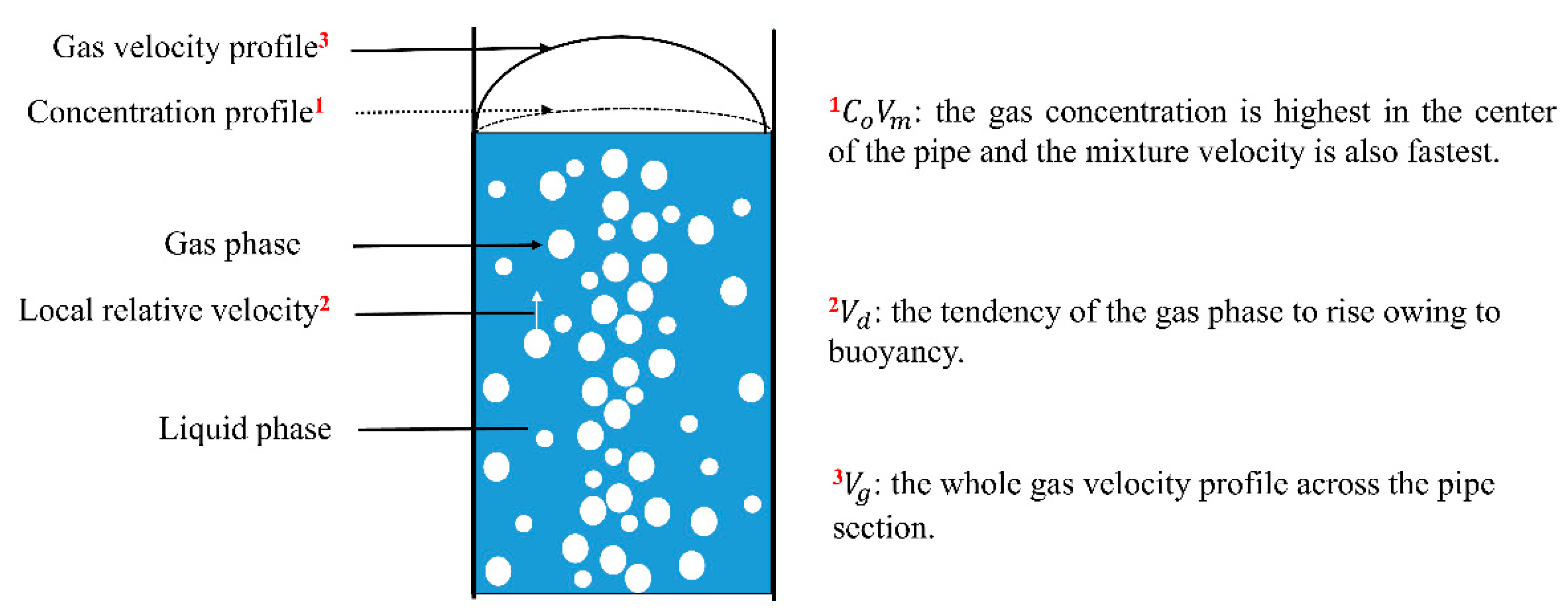
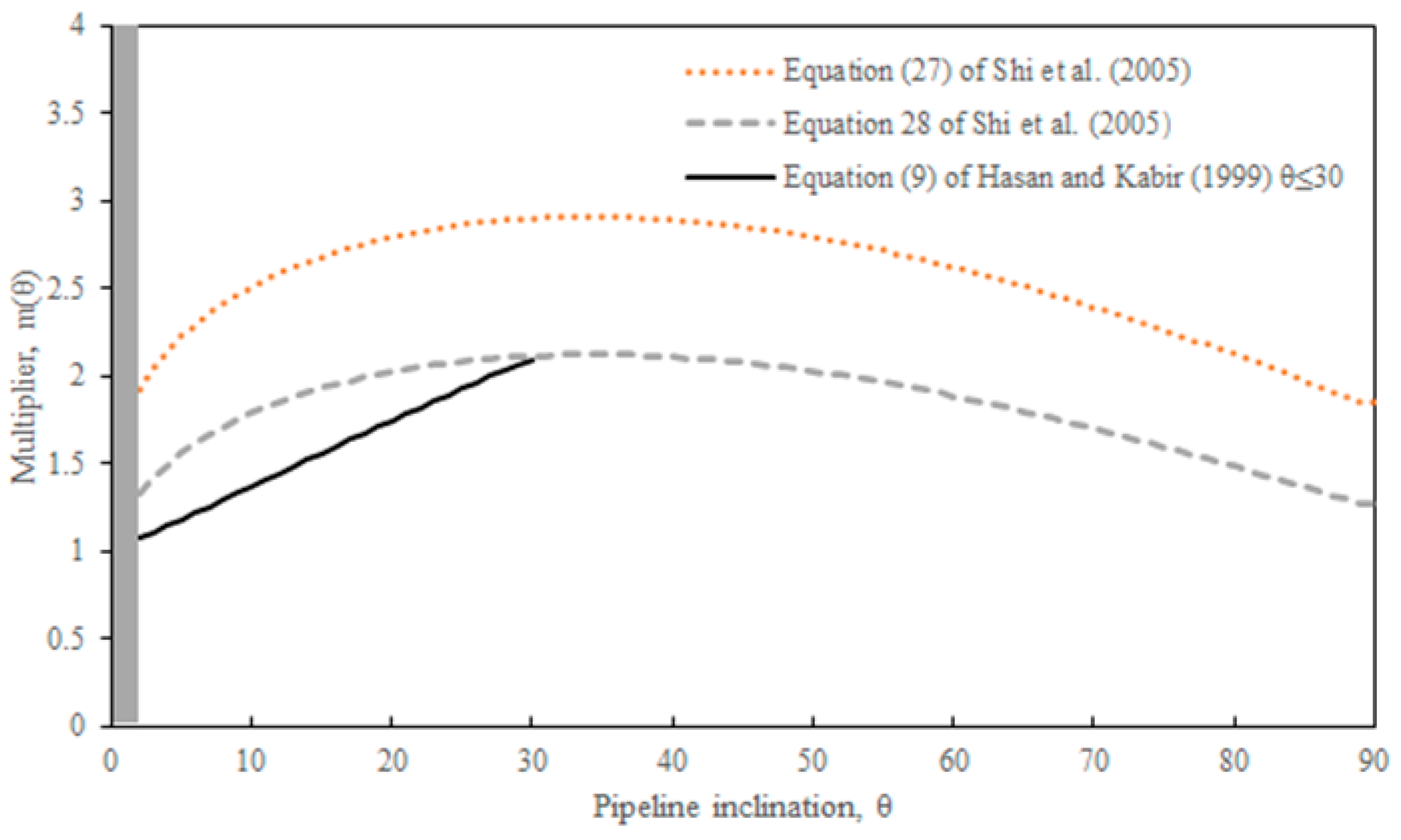
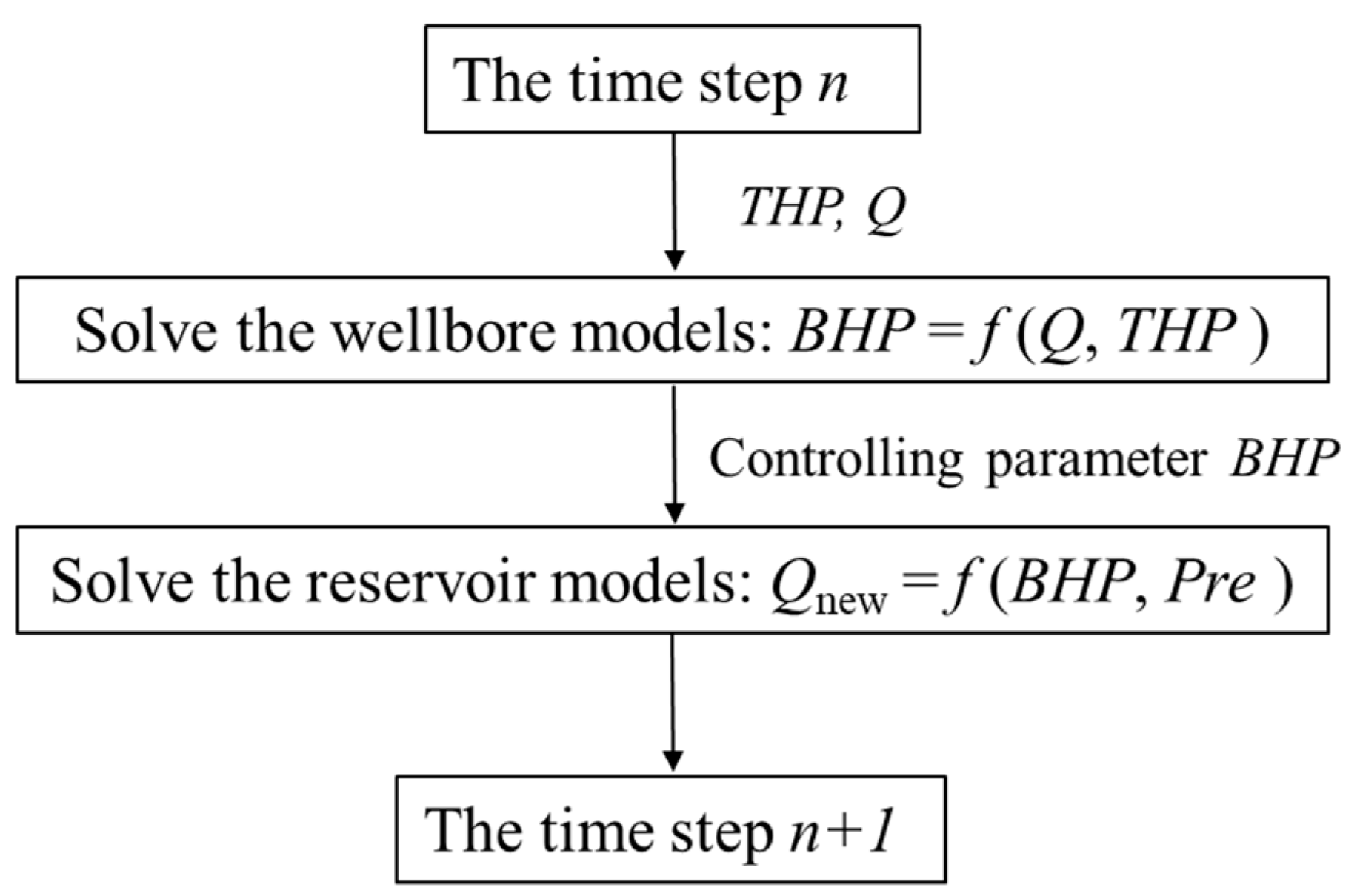
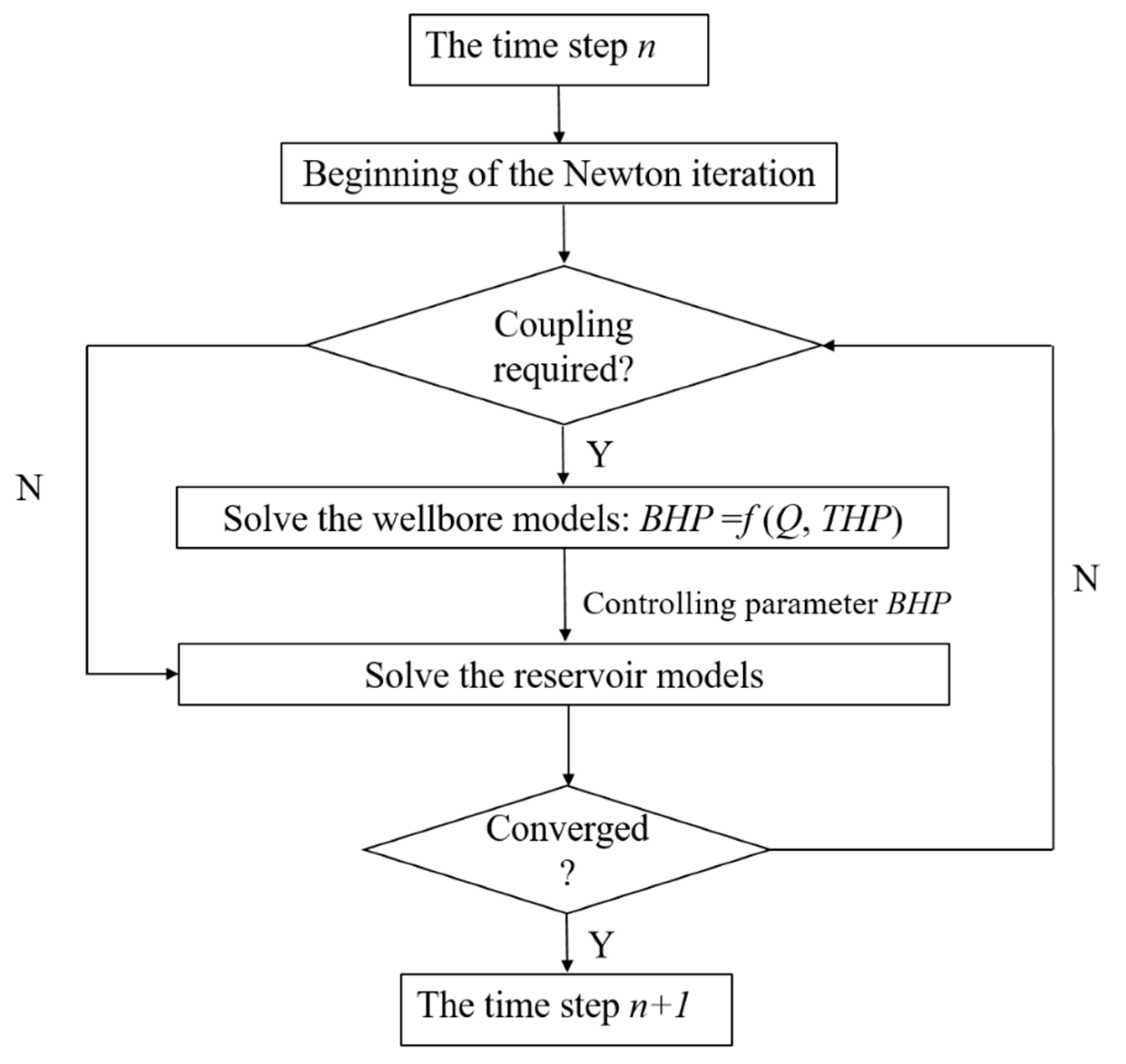
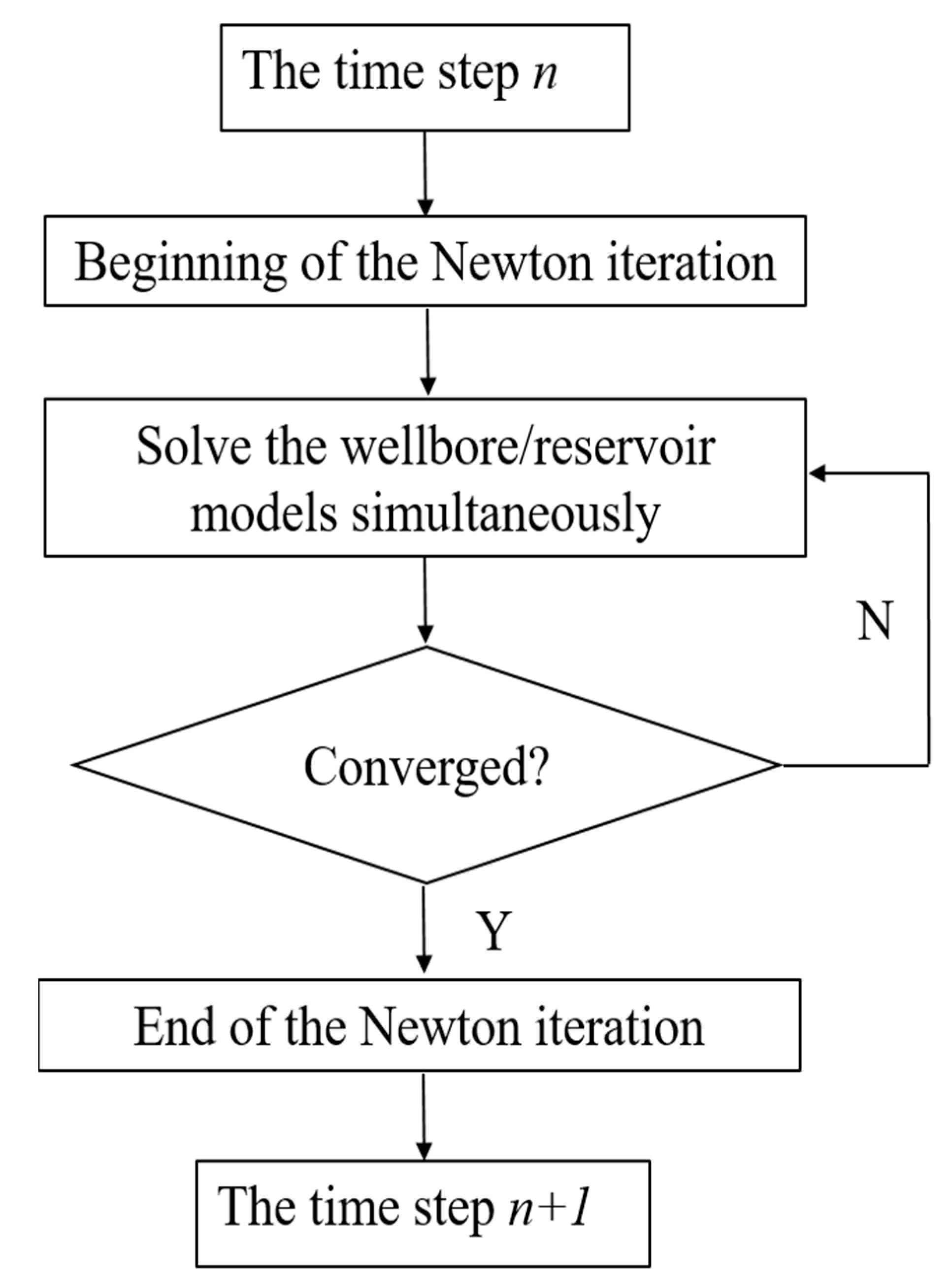

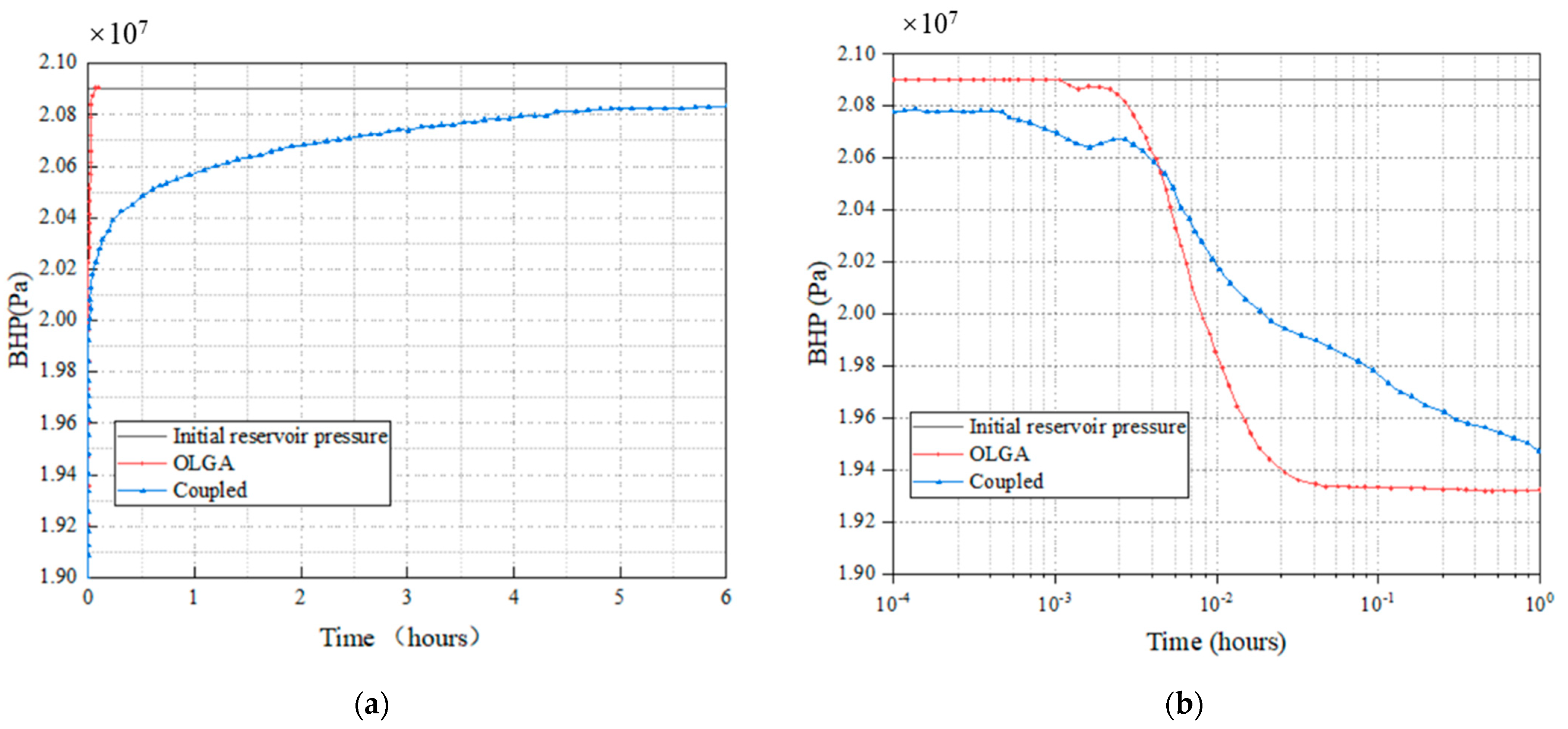

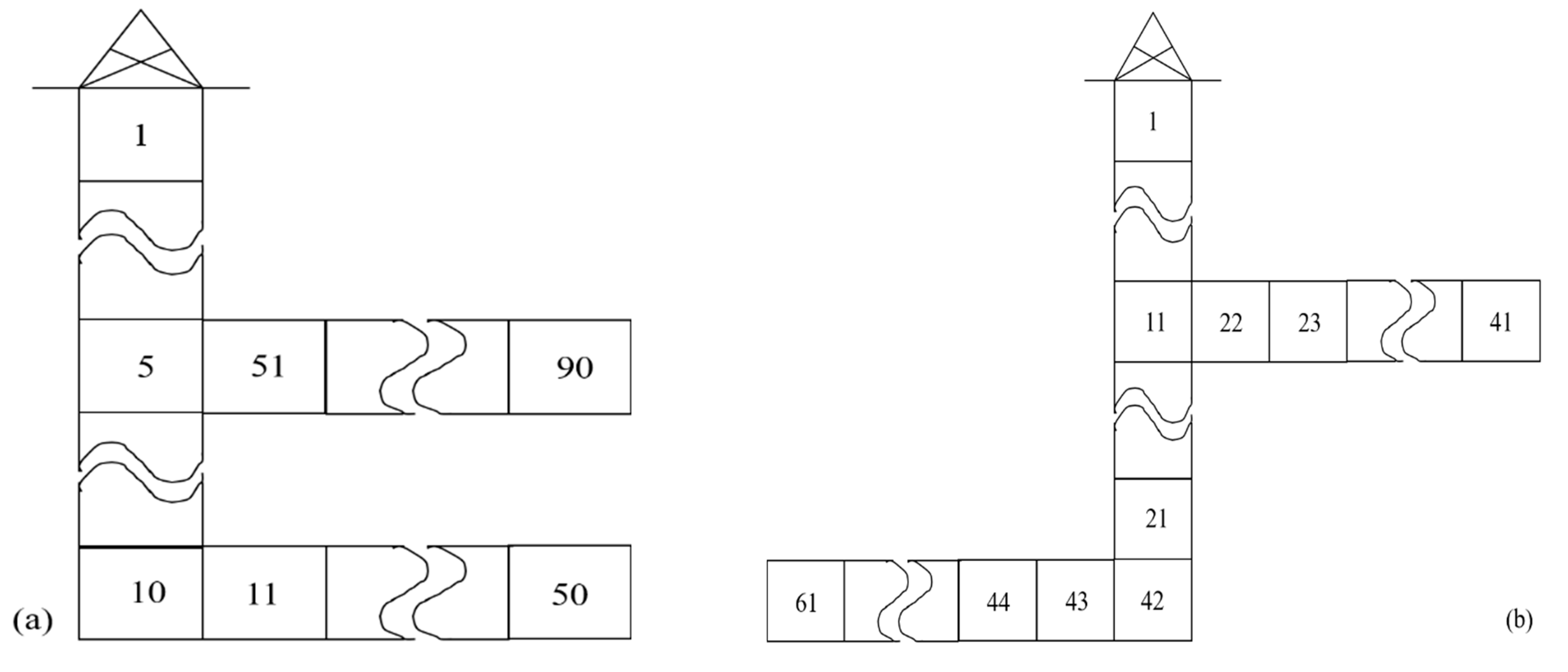
| Time | Author | Inclination, θ (degrees) | Pipe Diameter, D (cm) | Gas Superficial Velocity, Vg (m/s) | Liquid Superficial Velocity, VL (m/s) |
|---|---|---|---|---|---|
| 1967 | Eaton [99]. | 0 | 10.20 | [0.112, 21.901] | [0.011, 2.108] |
| 1972 | Beggs [100] | [−10, 10] | 2.54 | [0.299, 25.323] | [0.023, 5.203] |
| 1976 | Schmidt [101] | 90 | 5.08 | [0.042, 13.146] | [0.070, 2.146] |
| 1977 | Cheremisinoff [102] | 0 | 6.35 | [2.582, 25.241] | [0.017, 0.070] |
| 1980 | Mukherjee [103] | [−90, 90] | 3.81 | [0.037, 41.310] | [0.015, 4.362] |
| 1980 | Akpan [104] | 0 | 7.62 | [0.199, 5.458] | [0.137, 1.701] |
| 1982 | Vongvuthipornchai [105] | 0 | 7.62 | [0.061, 2.938] | [0.070, 2.146] |
| 1983 | Minami [106] | 0 | 7.79 | [0.475, 16.590] | [0.005, 0.951] |
| 1986 | Caetano [107] | 90 | 6.34 | [0.023, 22.859] | [0.002, 3.579] |
| 1986 | Kouba [108] | 0 | 7.62 | [0.302, 7.361] | [0.152, 2.137] |
| 1986 | Rothe et al. [109] | [−2, 0] | 17.10 | [0.610, 4.633] | [0.061, 1.830] |
| 1992 | Felizola [110] | [0, 90] | 5.10 | [0.390, 3.360] | [0.050, 1.490] |
| 1996 | Roumazeilles [111] | [−30, 0] | 5.10 | [0.914, 9.357] | [0.884, 2.438] |
| 1996 | Brill et al. [112] | [−10, 10] | 7.79 | [3.629, 12.656] | [0.004, 0.046] |
| 1999 | Meng [113] | [−2, 2] | 5.08 | [4.600, 26.600] | [0.001, 0.054] |
| 2000 | Abdul-Majeed [114] | 0 | 5.08 | [0.196, 49.908] | [0.002, 1.825] |
| 2005 | Fan [115] | [−2, 2] | 5.08 | [4.930, 25.700] | [0.0003, 0.052] |
| 2005 | Johnson [116] | [0, 5] | 10.00 | [0.711, 4.523] | [0.019, 0.605] |
| 2009 | Magrini [117] | [0, 90] | 7.62 | [36.630, 82.320] | [0.003, 0.040] |
| 2011 | Yuan [118] | [30, 90] | 7.62 | [9.900, 36.000] | [0.005, 0.100] |
| 2012 | Guner [119] | [0, 45] | 7.62 | [1.485, 39.388] | [0.010, 0.100] |
| 2013 | Alsaadi [120] | [2, 30] | 7.62 | [1.829, 39.992] | [0.010, 0.101] |
| Author | Inclination θ (Degrees) | Correlation |
|---|---|---|
| Shi et al. [60,61] | [+2, +90] | |
| Li et al. [121] | [−5, +90] | |
| Choi et al. [93] | [−30, 90] | |
| Bhagwat and Ghajar [94] | [−90, 90] | |
| Tang et al. [53] | [0, 90] | |
| Tang et al. [82,83] | [−90, 90] |
| Author (s) | Coupled Reservoir/Wellbore Simulation | Coupling Scheme |
|---|---|---|
| Stone et al. [26] | M, T, B, SF, H | F |
| Almehaideb et al. [14] | M, N, B, SF, V | F |
| Winterfeld [30] | M, N, B, SM, V | F |
| Holmes et al. [12] | M, ?, B, DF, M | F |
| Stone et al. [25] | M, T, C, DF, M | I |
| Coats et al. [9] | M, N, C, ?, M | F |
| Bhat et al. [16] | S, T, B, ?, H | I |
| Nennie et al. [1] | M, T, B, SF, M | E |
| Sagen et al. [23] | M, T, B, ?, M | F |
| Pourafshary [22] | M, T, C, DF, V | F |
| Leemhuis et al. [19] | M, T, B, SF, M | E |
| Livescu et al. [20] | M, T, C, DF, M | F |
| Livescu et al. [50] | M, T, B, DF, M | F |
| Semenova et al. [85] | M, T, C, DF, M | F |
| Twerda et al. [29] | M, T, B, SF, M | F |
| Bahonar et al. [15] | S, T, B, ?, V | F |
| Shirdel [52] | S, N, C, ?, H | F |
| Pan and Oldenburg [21] | M, T, C, DF, V | F |
| Gao [129] | M, N, B, SM, V&H | I |
| Forouzanfar et al. [48] | M, T, C, DF, V | F |
| Cao et al. [17] | M, N, C, ?, M | F |
| Olivares [99] | M, N, C, SM, V | F |
| Redick [130] | M, N, B, ?, V | I |
| Tang et al. [96] | M, N, C, DF, H | F |
| Galvao et al. [33] | S, T, C, ?, V | E |
| Galvao et al. [133] | S, T, C, ?, V | E |
| Basirat et al. [32] | M, T, C, DF, V | F |
| Battistelli et al. [31] | M, T, C, DF, V | F |
| Raad et al. [34] | M, T, B, ?, V | E |
| Liao et al. [35] | M, T, B, ?, H | F |
Publisher’s Note: MDPI stays neutral with regard to jurisdictional claims in published maps and institutional affiliations. |
© 2022 by the authors. Licensee MDPI, Basel, Switzerland. This article is an open access article distributed under the terms and conditions of the Creative Commons Attribution (CC BY) license (https://creativecommons.org/licenses/by/4.0/).
Share and Cite
Peng, L.; Han, G.; Chen, Z.; Pagou, A.L.; Zhu, L.; Abdoulaye, A.M. Dynamically Coupled Reservoir and Wellbore Simulation Research in Two-Phase Flow Systems: A Critical Review. Processes 2022, 10, 1778. https://doi.org/10.3390/pr10091778
Peng L, Han G, Chen Z, Pagou AL, Zhu L, Abdoulaye AM. Dynamically Coupled Reservoir and Wellbore Simulation Research in Two-Phase Flow Systems: A Critical Review. Processes. 2022; 10(9):1778. https://doi.org/10.3390/pr10091778
Chicago/Turabian StylePeng, Long, Guoqing Han, Zhangxing Chen, Arnold Landjobo Pagou, Liying Zhu, and Akhayie Mamat Abdoulaye. 2022. "Dynamically Coupled Reservoir and Wellbore Simulation Research in Two-Phase Flow Systems: A Critical Review" Processes 10, no. 9: 1778. https://doi.org/10.3390/pr10091778
APA StylePeng, L., Han, G., Chen, Z., Pagou, A. L., Zhu, L., & Abdoulaye, A. M. (2022). Dynamically Coupled Reservoir and Wellbore Simulation Research in Two-Phase Flow Systems: A Critical Review. Processes, 10(9), 1778. https://doi.org/10.3390/pr10091778







